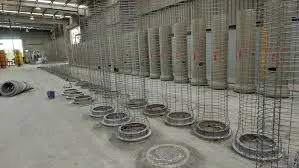Nov . 09, 2024 19:08 Back to list
Manufacturers of Cast Silicon Aluminum Alloys for Heat Exchanger Applications
The Role of Cast Silicon Aluminum Alloy in Heat Exchanger Manufacturing
In the realm of modern engineering, the efficiency and performance of heat exchangers are paramount, particularly in industries such as automotive, aerospace, and HVAC (heating, ventilation, and air conditioning). As the demand for sustainable and high-performance materials continues to grow, manufacturers have increasingly turned to cast silicon aluminum alloys. These alloys bring a unique set of properties to heat exchanger design, making them a material of choice for various applications.
Understanding Cast Silicon Aluminum Alloys
Cast silicon aluminum alloys are primarily composed of silicon and aluminum, with silicon content typically ranging from 5% to 20%. The addition of silicon enhances the casting characteristics of aluminum, resulting in alloys that can be easily molded into complex shapes. This attribute is crucial for heat exchanger manufacturing, where intricate designs are often necessary to maximize surface area and improve thermal transfer.
In addition to their excellent casting capabilities, silicon aluminum alloys exhibit good corrosion resistance and improved fluidity during the casting process. These properties allow for smoother finishes and more precise dimensions, which are essential for ensuring optimal heat exchange efficiency.
Thermal Conductivity and Performance
One of the most critical factors in heat exchanger design is thermal conductivity. Cast silicon aluminum alloys offer a balance between lightweight construction and thermal efficiency. While conventional metals like copper and brass provide superior thermal conductivity, silicon aluminum alloys have proven effective in many applications due to their ability to dissipate heat effectively without excessive weight.
The thermal performance of these alloys is particularly beneficial in environments where weight reduction is essential, such as in the automotive and aerospace industries
. As manufacturers strive to develop lighter vehicles and aircraft to enhance fuel efficiency, cast silicon aluminum alloys provide an attractive alternative.cast silicon aluminum alloy heat exchanger manufacturers

Manufacturing Process and Challenges
The manufacturing process of cast silicon aluminum alloy heat exchangers involves careful control of several factors, including alloy composition, melting temperature, and casting methods. Techniques such as sand casting, die casting, and investment casting are commonly employed, each presenting its own set of challenges.
One of the main challenges in using these alloys is their susceptibility to casting defects like porosity and shrinkage. Effective quality control measures must be implemented during the casting process to minimize these defects, ensuring the structural integrity and performance reliability of the final product.
Future Trends in Heat Exchanger Design
As industries continue to evolve, the demand for advanced materials in heat exchanger design is increasing. Manufacturers are actively exploring how to enhance the properties of cast silicon aluminum alloys through alloying elements and innovative casting techniques. For example, integrating nanomaterials or optimizing heat treatment processes may lead to alloys with improved mechanical and thermal properties.
Moreover, sustainability is becoming a significant driving force in manufacturing. Recyclability and resource conservation are essential considerations, and aluminum alloys, including silicon variants, can be recycled effectively, making them a sustainable choice in the long term.
Conclusion
In conclusion, cast silicon aluminum alloy heat exchanger manufacturers play a crucial role in meeting the demands of modern applications. By leveraging the unique properties of these alloys, manufacturers can create efficient, lightweight, and corrosion-resistant heat exchangers suited for various industries. As technology advances, the continued development of these materials promises to enhance the performance and sustainability of heat exchangers, ensuring they remain integral to the industry for years to come.
-
Centrifugally Cast Iron Water Main Pipe | Ductile Iron Solutions
NewsAug.24,2025
-
Durable Cast Steel Concrete Pipe Mold Bottom Rings & Base Trays
NewsAug.23,2025
-
Centrifugally Cast Iron Water Main Pipe for Reliable Mains
NewsAug.22,2025
-
Durable Centrifugally Cast Iron Water Main Pipe
NewsAug.11,2025
-
Centrifugally Cast Iron Water Main Pipes for Reliability
NewsAug.10,2025
-
High-Quality Centrifugally Cast Iron Water Main Pipes
NewsAug.09,2025


